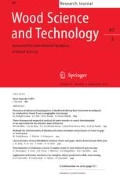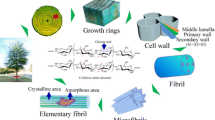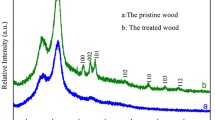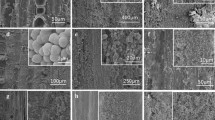Abstract
A hydrothermal method of fabricating nanomaterials at wood surfaces is described in this paper. Nanomaterials with different morphologies including spherical anatase TiO2, amorphous SiO2, wurtzite ZnO nanorod arrays, intertwining MnO2 nanowires, shuttle-shaped CaCO3 nanorods, and rhombic and cubic NaCl were deposited at wood surfaces. TiO2–ZnO compound nanoparticles and CuO nanoparticles were also created. The surface morphologies and crystalline structures of the prepared samples were characterized by scanning electron microscopy and X-ray diffraction, respectively. No obvious changes in the color of wood were caused by the hydrothermal process except those nanomaterials of Mn or Cu deposited at surfaces.



Similar content being viewed by others
References
Bourbigot S, Duquesne S (2007) Fire retardant polymers: recent developments and opportunities. J Mater Chem 17:2283–2300
Byrappa K, Adschiri T (2007) Hydrothermal technology for nanotechnology. Prog Cryst Growth Charact Mater 53:117–166
Collett BM (1972) A review of surface and interfacial adhesion in wood science and related fields. Wood Sci Technol 6:1–42
Evans PD, Chowdhury M (2010) Photoprotection of wood using polyester-type UV-absorbers derived from the reaction of 2-hydroxy-4(2,3-epoxypropoxy)-benzophenone with dicarboxylic acid anhydrides. J Wood Chem Technol 30:186–204
Ghosh SK (2006) Functional coatings and microencapsulation: a general perspective. Wiley-VCH Verlag GmbH & Co. KGaA, Weinheim
Hansmann C, Weichslberger G, Gindl W (2005) A two-step modification treatment of solid wood by bulk modification and surface treatment. Wood Sci Technol 39:502–511
Hill CAS (2006) Wood modification: chemical, thermal and other processes. Wiley, Chichester
Jamali A, Evans PD (2011) Etching of wood surfaces by glow discharge plasma. Wood Sci Technol 45:169–182
Jebrane M, Sèbe G, Cullis I, Evans PD (2009) Photostabilisation of wood using aromatic vinyl esters. Polym Degrad Stab 94:151–157
Kalliat M, Kwak CY, Schmidt PW, Cutter BE, McGinnes EA (1983) Small angle X-ray scattering measurement of porosity in wood following pyrolysis. Wood Sci Technol 17:241–257
Kataoka Y, Kiguchi M, Williams R, Evans PD (2007) Violet light causes photodegradation of wood beyond the zone affected by ultraviolet light. Holzforschung 61:23–27
Kumar S (1994) Chemical modification of wood. Wood Fiber Sci 26(2):270–280
Kumar M, Gupta RC, Sharma T (1993) X-ray diffraction studies of Acacia and Eucalyptus wood chars. J Mater Sci 28:805–810
LeVan S, Winandy J (1990) Effects of fire retardant treatments on wood strength: a review. Wood Fiber Sci 22:113–131
Li J, Yu H, Sun Q, Liu Y, Cui Y, Lu Y (2010) Growth of TiO2 coating on wood surface using controlled hydrothermal method at low temperatures. Appl Surf Sci 256(16):5046–5050
Mai C, Militz H (2004) Modification of wood with silicon compounds. Treatment systems based on organic silicon compounds—a review. Wood Sci Technol 37:453–461
Marney DCO, Russell LJ (2008) Combined fire retardant and wood preservative treatments for outdoor wood applications—a review of the literature. Fire Technol 44:1–14
Miyafuji H, Saka S (2001) Na2O–SiO2 wood-inorganic composites prepared by the sol-gel process and their fire-resistant properties. J Wood Sci 47:483–489
Paakkari T, Serimaa R (1984) A study of the structure of wood cells by x-ray diffraction. Wood Sci Technol 18:79–85
Pinto RJB, Marques PAAP, Barros-Timmons AM, Trindade T, Neto CP (2008) Novel SiO2/cellulose nanocomposites obtained by in situ synthesis and via polyelectrolytes assembly. Compos Sci Technol 68:1088–1093
Rautkari L, Properzi M, Pichelin F, Hughes M (2009) Surface modification of wood using friction. Wood Sci Technol 43:291–299
Sarén M-P, Serimaa R (2006) Determination of microfibril angle distribution by X-ray diffraction. Wood Sci Technol 40:445–460
Sèbe G, Brook MA (2001) Hydrophobization of wood surfaces: covalent grafting of silicone polymers. Wood Sci Technol 35:269–282
Subramaniana RV, Balabaa WM, Somasekharan KN (1982) Surface modification of wood using nitric acid. J Adhes 14(3–4):295–304
Sun Q, Yu H, Liu Y, Li J, Cui Y, Lu Y (2010a) Prolonging the combustion duration of wood by TiO2 coating synthesized using cosolvent-controlled hydrothermal method. J Mater Sci 45:6661–6667
Sun Q, Yu H, Liu Y, Li J, Lu Y, Hunt JF (2010b) Improvement of water resistance and dimensional stability of wood through titanium dioxide coating. Holzforschung 64:757–761
Sun Q, Lu Y, Liu Y (2011) Growth of hydrophobic TiO2 on wood surface using a hydrothermal method. J Mater Sci 46:7706–7712
Tshabalala M, Sung L-P (2007) Wood surface modification by in situ sol–gel deposition of hybrid inorganic–organic thin films. J Coat Technol Res 4:483–490
Wang C, Piao C (2011) From hydrophilicity to hydrophobicity: a critical review—part II: hydrophobic conversion. Wood Fiber Sci 43:41–56
Williams RS (1983) Effect of grafted UV stabilizers on wood surface erosion and clear coating performance. J Appl Poly Sci 28(6):2093–2103
Yang D, Zheng Z, Zhu H, Liu H, Gao X (2008) Titanate nanofibers as intelligent absorbents for the removal of radioactive ions from water. Adv Mater 20:2777–2781
Yang D, Liu H, Zheng Z, Yuan Y, Zhao J, Waclawik ER, Ke X, Zhu H (2009) An efficient photocatalyst structure: TiO2(B) nanofibers with a shell of anatase nanocrystals. J Am Chem Soc 131:17885–17893
Yang D, Sarina S, Zhu H, Liu H, Zheng Z, Xie M, Smith SV, Komarneni S (2011) Capture of radioactive cesium and iodide ions from water by using titanate nanofibers and nanotubes. Angew Chem Int Ed 50:10594–10598
Zanini S, Riccardi C, Orlandi M, Fornara V, Colombini M, Donato D, Legnaioli S, Palleschi V (2008) Wood coated with plasma-polymer for water repellence. Wood Sci Technol 42:149–160
Acknowledgments
This work was supported by the Breeding Plan of Excellent Doctoral Dissertation of Northeast Forestry University (GRAP09), the Program of Introducing Talents of Discipline to Universities of China (B08016).
Author information
Authors and Affiliations
Corresponding author
Additional information
Qingfeng Sun and Yun Lu are co-first authors.
Rights and permissions
About this article
Cite this article
Sun, Q., Lu, Y., Yang, D. et al. Preliminary observations of hydrothermal growth of nanomaterials on wood surfaces. Wood Sci Technol 48, 51–58 (2014). https://doi.org/10.1007/s00226-013-0570-7
Received:
Published:
Issue Date:
DOI: https://doi.org/10.1007/s00226-013-0570-7




